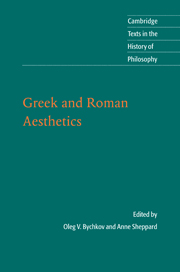Book contents
- Frontmatter
- Contents
- Preface
- Introduction
- Chronology
- Further reading
- Note on the texts and the translations
- Greek and Roman Aesthetics
- Gorgias
- Plato
- Xenophon
- Aristotle
- Philodemus
- Cicero
- Seneca
- Longinus
- Philostratus
- Philostratus the Younger
- Aristides Quintilianus
- Plotinus
- Augustine
- Proclus
- Index
- CAMBRIDGE TEXTS IN THE HISTORY OF PHILOSOPHY
Philostratus
Published online by Cambridge University Press: 05 June 2012
- Frontmatter
- Contents
- Preface
- Introduction
- Chronology
- Further reading
- Note on the texts and the translations
- Greek and Roman Aesthetics
- Gorgias
- Plato
- Xenophon
- Aristotle
- Philodemus
- Cicero
- Seneca
- Longinus
- Philostratus
- Philostratus the Younger
- Aristides Quintilianus
- Plotinus
- Augustine
- Proclus
- Index
- CAMBRIDGE TEXTS IN THE HISTORY OF PHILOSOPHY
Summary
Life of Apollonius of Tyana
2.22
Apollonius spent a long time in the temple, until the king had been told that the strangers had arrived. During this time the following conversation took place.
‘Damis,’ said Apollonius, ‘is there such a thing as painting?’
‘Yes indeed,’ he replied, ‘if there is also such a thing as truth.’
‘What does this art do?’
‘It mixes all the different colours together,’ said Damis, ‘blue with green, white with black and red with yellow.’
‘For what purpose does it mix them?’ Apollonius asked. ‘For it is not just to obtain a bright colour, like dyed wax.’
‘The purpose is imitation,’ said Damis, ‘to make likenesses of dogs and horses and people and ships and everything under the sun. And what is more, it makes a likeness of the sun himself, sometimes in a four-horse chariot, as he is said to appear in this world, and sometimes actually carrying a torch across the sky, when the painting depicts the upper air and the home of the gods.’
‘So is painting imitation, Damis?’
‘What else could it be?’ said Damis. ‘If it did not do this, we would think it ridiculous, foolishly concocting colours.’
‘What will you say about the shapes we see in the sky when the clouds are torn apart from each other, the centaurs and goat-stags and, by Zeus, the wolves and the horses? Are they not products of imitation?’
- Type
- Chapter
- Information
- Greek and Roman Aesthetics , pp. 167 - 170Publisher: Cambridge University PressPrint publication year: 2010

